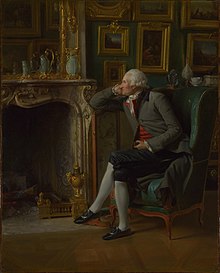Henri-Pierre Danloux (24 February 1753 – 3 January 1809) was a French painter and draftsman.

He was born in Paris. After the early death of his parents, Danloux was brought up by his architect uncle, Guillaume-Elie Lefoullon. First Danloux was a pupil of Lépicié and later of Vien, whom he followed to Rome in 1775. In 1783, he returned to Lyon and Paris, where he was patroned by the Baronne Mégret de Sérilly d'Etigny, who secured for him a number of important portrait commissions exclusively for the aristocracy. He emigrated to London in 1792 thereby escaping the French Revolution and its potential consequences.[1][2][3][4]
The years of exile in England and death in Paris
editWhile in England, he was commissioned for portraits of the officer class and the well-to-do. Members of one such family, the Lamberts of Oxfordshire, engaged the master in 1800 and had sittings for its individual members: father, mother and son (Henry John Lambert, Bt.), himself, later in life, serving in the Grenadier Regiment of Foot Guards, a Deputy Lieutenant for Oxfordshire and High Sheriff [Peter Lambert from a letter - Pawsey & Payne, 1973]. Danloux, returned to Paris in 1801, there resuming his career. He died in Paris in 1809.[5][6][4]
Danloux was influenced by fashionable English portrait painters such as Thomas Lawrence (1769–1830), John Hoppner (1758–1810), and George Romney (1734–1802). In 1793, he exhibited at the Royal Academy in London which resulted in commissions from a number of British patrons.[4]
Gallery
edit-
Épisode du Déluge, by Henri-Pierre Danloux (before 1802)
-
A young boy pleading with his older sister for the return of his Polichinelle puppet, by Henri-Pierre Danloux (between 1770 and 1800)
-
Madame de L'Horme and her son Jean-Louis, by Henri-Pierre Danloux (1801)
-
Gentleman in a grey coat, by Henri-Pierre Danloux (around 1800)
See also
edit- The Skating Minister and the attribution controversy: In March 2005, a curator from the Scottish National Portrait Gallery suggested that the painting is by French artist Henri-Pierre Danloux rather than by Henry Raeburn.[7][8]
References
edit- ^ "nationalgallery.org.uk". Archived from the original on 2008-11-22. Retrieved 2008-12-02.
- ^ Le Louvre Paris: Henri-Pierre Danloux – Peintre et Graveur, Biographie, site-web, Les collections du département des arts graphiques du Louvre, consulté le 10 février 2024.
- ^ Larousse: Henri-Pierre Danloux, Encyclopédie (peinture), biographie, site-web, consulté le 10 février 2024.
- ^ a b c RKD – Netherlands Institute for Art History: Henri-Pierre Danloux, Biographie, website. Retrieved 10 February 2024.
- ^ "nationalgallery.org.uk". Archived from the original on 2008-11-22. Retrieved 2008-12-02.
- ^ Pawsey & Payne: The portrait of the son, Sir Henry John Lambert Bt., Fine Art Dealers & valuations and restoration, 1 Bury Street, St. James's, London S.W. Letter of valuation dated April 12, 1973: The portrait of the son, Sir Henry John Lambert Bt., ...is illustrated and recorded in Baron Roget's book on Danloux and family records refer to the sittings.
- ^ Blackley, Michael (2005-03-30). "Doubts over Skating Minister cut no ice with art experts". The Scotsman. Retrieved 2010-05-28.
- ^ Taylor, Alan (2005-08-07). "The Skating Minister: enduring masterpiece by the great Scottish artist Henry Raeburn, or just a rather nice painting by an obscure Frenchman?". The Herald, Scotland. Retrieved 2010-05-28.
Further reading
edit- Olivier Meslay,« Henry-Pierre Danloux (1753-1809), sa carrière avant l’exil en Angleterre », Bulletin de la Société d’Histoire de l’Art Français, Paris, 2007 (année 2006), p. 209-244.
- Olivier Meslay, « L’enrichissement d’un fonds ancien de la collection Jacques Doucet : les archives Portalis et Danloux », Les Nouvelles de l’INHA, Décembre 2009, p. 18-21.
- Olivier Meslay, "La famille d’Etigny et le peintre Henri-Pierre Danloux", Bulletin de la Société archéologique du Gers, 2004/4, p. 459-465.
- Olivier Meslay “Le Sublime social ou la Pitié mise en pièce” in Mehdi Korchane, Figure de l’exil de Bléisaire à Marcus Sextus, Musée de la Révolution Française, 2016, p. 80 à 91.
- Olivier Meslay “Beauté d’un ordre renversé : Danloux et l’image de l’émigration” in Mehdi Korchane, Figure de l’exil de Bléisaire à Marcus Sextus, Musée de la Révolution Française, 2016, p. 80 à 91.
External links
edit